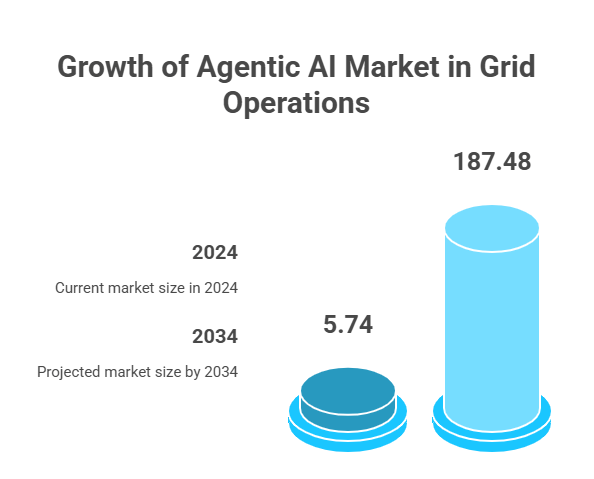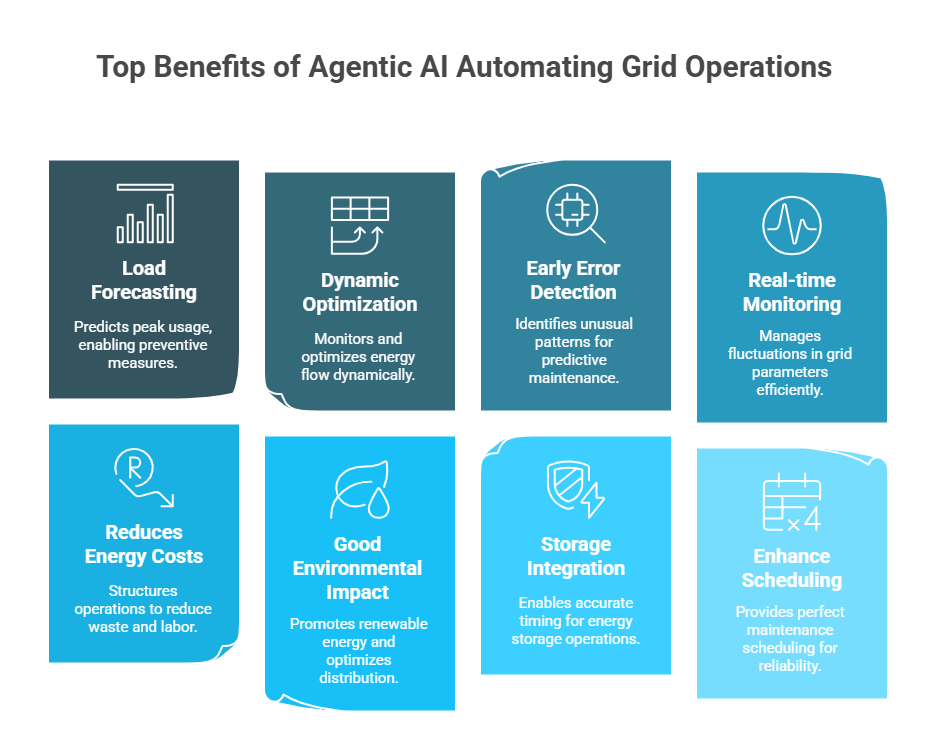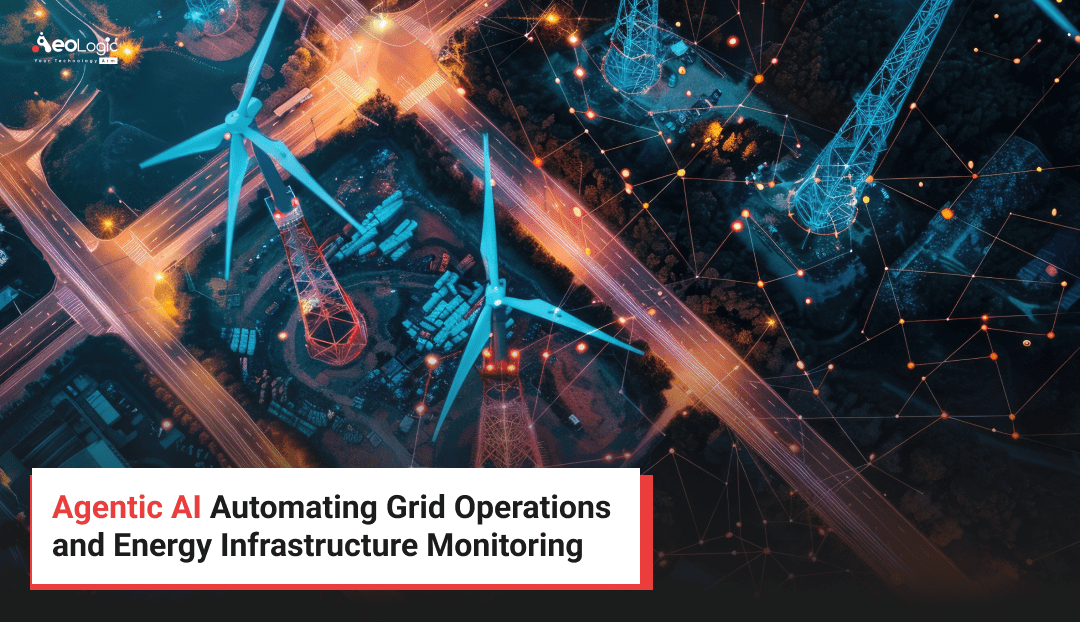Energy management is a crucial aspect of establishing sustainability and saving energy for future generations. Electrical energy is one of the most widely used forms of energy worldwide. Electrical energy involves grid operations that include generation, transmission, and distribution of electrical energy in an efficient manner. But the traditional techniques are too slow, inefficient, and enable bad energy management. Agentic AI in automating grid operations is crucial to enhance the grid operational efficiency and proper monitoring of the whole energy infrastructure in a better manner.
The traditional system creates various issues like unnecessary load situations, poor energy flow optimization, non-detection of potential issues, poor maintenance operations, inefficient distribution, unoptimized transmission routes, high costs, and poor environmental impacts. The development of agentic AI solutions has been solving these issues to enhance the grid operations and energy infrastructure monitoring in a much better way.
How Agentic AI in Grid Operations Enhances Energy Monitoring
The agentic AI solutions are developed to automate the tasks or operations that can automate the whole grid operations, whether it is generation, transmission, or distribution. All grid operations create an energy infrastructure that requires proper monitoring, which can also be enhanced with the agentic AI solutions.
These solutions offer a lot of benefits like load forecasting, demand response, dynamic energy flow optimization, early detection of potential issues, better maintenance scheduling, real-time monitoring and response system development, integration with energy storage, reducing bad environmental impacts, and much more. Overall, the agentic AI solutions can strengthen the energy management infrastructure that makes use of energy in the proper manner for years to years.
Key Statistics Shaping the Future of Agentic AI in Grid Operations

The rapid growth of Agentic AI in grid operations and energy infrastructure monitoring continues as demand for smarter, more efficient, and sustainable energy management solutions continues to necessitate a divergence from conventional methods (business as usual).
Here are some statistics that illustrate the scale and rapid growth of this transformational technology:
- The global agentic AI market size was reached at USD 5.74 billion in 2024 and is expected to be worth around USD 187.48 billion by 2034, exhibiting a compound annual growth rate (CAGR) of 41.71% over the forecast period from 2025 to 2034.
- According to Market.us, the Global Agentic AI in Energy Market is anticipated to reach approximately USD 10,700 million by 2034, rising from USD 480 million in 2024, with a remarkable CAGR of 36.40% between 2025 and 2034.
- The Smart Grid Management application emerged as the top use case in 2024, contributing more than 22% share, as energy firms focused on intelligent grid optimization.
- In 2024, the Platform/Software Solutions segment led the market with over 66% share, driven by demand for autonomous decision-making tools in energy systems.
Overall, these statistics demonstrate the importance of Agentic AI in fundamentally transforming grid operations and monitoring of energy infrastructure with economic and environmental benefits for energy providers and residential and business consumers.
Also Read: The Future of Agentic Process Automation
What Is Agentic AI Automating Grid Operations?
The agentic AI-powered automating grid operations refers to the integration of agentic AI solutions in the grid operations for automating the processes or operations like generation of energy, transmission of electrical energy, and distribution of energy without or with minimal human interaction.
All grid operations involve infrastructure that requires continuous or regular monitoring to avoid any mistakes or errors. The human-enabled monitoring system can be inaccurate and result in damage to the whole infrastructure. The agentic AI-powered monitoring enables real-time monitoring and automatic response to any anomalies on time to prevent any damage.
Explore more: The Role of AI Agents in the Future of Warehouse Automation
How Agentic AI Works in Grid Operations: Key Technologies and Algorithms
When considering agentic AI’s capability to transform grid operations, it is important to first be familiar with the underpinnings of the technology and algorithms that enable this transformation. Agentic AI in Grid Operations are autonomous intelligent agents that can learn and adapt while making decisions for optimizing complex energy grids.
These technologies work in the back end to process real-time data, monitor imminent changes, and respond efficiently in order to support stability and efficiency throughout energy infrastructures.
Let’s take a look at some of the AI technologies and algorithms that allow this to happen:
| Technology / Algorithm | Description | Role in Grid Operations |
|---|---|---|
| Reinforcement Learning (RL) | A type of machine learning where agents learn optimal actions through trial and error using rewards and penalties. | Enables the AI to continuously improve grid management decisions by learning from outcomes like load balancing and fault handling. |
| Multi-Agent Systems (MAS) | Multiple intelligent agents that communicate and cooperate to achieve complex tasks. | Models the distributed nature of energy grids, allowing decentralized decision-making and coordinated control across multiple grid components. |
| Deep Learning | Neural networks with multiple layers that can extract complex patterns from large datasets. | Used for load forecasting, anomaly detection, and predictive maintenance by analyzing vast amounts of sensor and historical data. |
| Natural Language Processing (NLP) | AI understanding and generating human language. | Facilitates interaction between operators and AI systems via conversational interfaces or voice commands, improving usability. |
| Optimization Algorithms | Mathematical techniques to find the best solution under constraints. | Helps in dynamic energy flow optimization, cost minimization, and efficient resource allocation in the grid. |
| Computer Vision | AI systems that interpret visual data. | Used to monitor physical infrastructure through cameras and drones, detecting damage or anomalies early. |
| Edge Computing | Processing data near the source rather than centralized cloud servers. | Enables real-time decision-making with minimal latency, crucial for instant responses in grid operations. |
| Digital Twins | Virtual replicas of physical assets or systems for simulation and analysis. | Allows simulation of grid behavior under different conditions, testing AI-driven strategies before applying them to the real grid. |
Use Cases of Agentic AI in Automating Grid Operations
Agentic AI is changing smart grid management at a rapid pace, and the automation of complex tasks. Examples of industry-specific use cases used by agentic AI, in terms of how agentic AI is improving efficiencies and innovation of energy grids include:
1. Automated Load Balancing
Agentic AI continuously monitors energy consumption patterns across the grid and balances load in real-time between generation and demand. Energy supply is balanced between and generation and demand to minimize the possibility of an outage, and remain stable even during peak usage hours.
2. Predictive Maintenance of Grid Equipment
Agentic AI monitors sensor data from infrastructure components like transformers and circuit and communication breakers to identify early indications of an impending failure. Early identification of this pattern enables clean scheduled predictive maintenance, leading to minimal disruption and avoidance of costly repairs.
3. Integration of Renewable Energy Sources
It can be challenging to manage some of the irregular nature of renewable sources, such as wind and solar energy, because of their intermittent availability. One solution agentic AI can manage the intermittent operations of renewable energy is to forecast renewable generation capacity, and make modifications to grid operations while ensuring clean energy flowing to the grid through renewable sources.
4. Fault Detection and Automatic Recovery
Agentic AI in Grid Operations detect in real-time such issues like short circuits or line failures, or a bad solar panel. An agentic AI that can automatically isolate that line in the event of a fault can react to any issue in three ways:
- Identify fault locations,
- Reroute electricity quickly to the workers fixing the fault, and
- Recover faster.
5. Demand Response Management
Agentic AI coordinates smart appliances and energy storage systems to reduce demand or shift load when demand is high, allowing grids to remain stable without human input.
6. Energy Theft Detection
Agentic AI analyzes trends and patterns in consumption to detect potential energy theft or meter tampering. It generates timely alarms for utility companies to act on.
7. Dynamic Pricing and Consumer Involvement
Agentic AI helps utilities establish dynamic rate models using demand forecasts to trigger changes in price. By engaging a consumer in increased controllable factors, energy can be used in a more efficient manner, which decreases overall stress on the grid.
8. Enhanced Grid Security
Agentic AI constantly monitors network traffic and system behavior. If evidence of malicious activity, such as a cyber threat or unauthorized access attempts found, utility companies have vital information to guard energy infrastructure.
Related Blog: Top Benefits of Using AI Agents for Smarter Logistics
Top Benefits of Agentic AI Automating Grid Operations and Energy Infrastructure Monitoring
There are a lot of benefits of agentic AI automating grid operations. Here are a few key benefits mentioned below.

Load Forecasting
There would be various instances when the energy load would be high due to high demands. This is important to stay prepared for those instances to prevent any type of sudden disruptions. The traditional system does not allow forecasting of load within the time that causes various issues to energy infrastructure and grid operations.
The agentic AI solutions can automatically analyze the historical data to find out the upcoming peak usage to make an alert to take preventive measures. This automatically handles the generation and transmission operations to make efficient balancing between demands and the transfer of energy.
Dynamic Energy Flow Optimization
The energy flow should be dynamic according to the requirements. Uncontrollable energy flow could disrupt the system, and also cause wastage of energy to disrupt sustainability. The traditional grid operations management system does not allow such flexibility.
The agentic AI-powered automatic solutions can monitor the energy flow and make dynamic changes to ensure proper optimization of energy flow. This reduces the wastage of energy and overload conditions.
Early Detection of Errors in Infrastructure
The grid operations and energy infrastructure involve various aspects and machinery that can make errors at any time. It would be great if finding errors or issues before they occur helps to make predictive maintenance. The agentic AI solutions have the potential that analyze the performance data to identify unusual patterns.
Any risk or issue factor detection immediately informs the managers to make maintenance. This prevents too much damage and reduces the downtime.
Real Time Monitoring and Response
Sometimes, the grid operations can enable fluctuation in the different parameters that overall affect the whole infrastructure. The traditional system does not have the potential to manage all fluctuations in real time.
The agentic AI-powered solutions can monitor all parameters of the grid operations and any fluctuation detection, enabling real-time response or management of those situations in a very efficient manner. This overall enables a smooth flow of energy to the consumers.
Reduces Energy Costs
Uncontrollable, unstructured, and inefficient management of grid operations leads to wastage and more labor costs, which overall increases the costs for consumers and suppliers both. The traditional system cannot manage all in a balanced manner.
The AI-powered automation solutions can automatically structure everything to reduce the wastage of energy and reduce the manual labor requirements. This overall reduces the costs for consumers and suppliers both.
Good Environmental Impact
Only energy saving and operations automation are not necessary, but it is also important to make a good environmental impact while doing all. The traditional system may manage the grid operations, but it can also impact the environment in various ways.
The agentic AI solutions promoted the renewable sources of energy development and optimized the energy distribution in a good manner. This enhances the environmental impact and increases sustainability practices.
Integration with Energy Storage
Energy storage management is crucial to provide a smooth flow of energy to the grid system. But traditionally or manually doing these cannot offer such smooth operations as changing and discharging timing could be altered.
The agentic AI solutions integration with the energy storage can enable accurate timing of charging and discharging of the energy storage, which enables smooth flow of energy to the grid that overall enhancing grid operations as well as energy infrastructure management.
Enhance Maintenance Scheduling
Unnecessary maintenance or after-hours maintenance could impact the machinery and grid operations in a bad way. The regular system does not enable accurate maintenance scheduling.
Where the agentic AI-powered automation can analyze different data, such as equipment lifespan, conditions, to provide the perfect maintenance scheduling for timely maintenance to enhance the reliability and whole energy infrastructure.
Also Read: How to Build a Custom AI Solution for Your Business 2025
Top Challenges in Using Agentic AI for Energy Infrastructure
We have seen various key benefits of the agentic AI solutions for grid operations and energy infrastructure. But there are a few key challenges too, as here few are mentioned below.
- The grid system and energy infrastructure are a network of different and complex systems. This involves various aspects that make it hard to integrate the agentic AI solutions efficiently. So integration would be a challenging factor with the agentic AI in the grid and energy management.
- During situations like load, faults, short circuit, etc, it requires immediate response, and agentic AI solutions could take some time to analyze the data to make any response. So it could be a concern too with the agentic AI solutions.
- Agentic AI solutions require consistent data flow. But sometimes, due to any technical error, the data availability would be an inconsistency that could affect the decision-making.
Comparison Between Traditional Grid Management and Agentic AI Solutions
To provide you with more clarity on differentiating features and benefits of Agentic AI in grid management and monitoring energy infrastructure, we provide this comparison table to show you how Agentic AI solutions outperform conventional grid management practices in a number of significant ways, improving efficiency, reliability and sustainability.
| Aspect | Traditional Grid Management | Agentic AI Solutions |
|---|---|---|
| Automation Level | Mostly manual operations with limited automation | Fully automated with minimal human intervention |
| Real-Time Monitoring | Limited, often delayed data collection and response | Continuous real-time monitoring and instant response |
| Load Forecasting | Basic or no predictive capabilities | Advanced predictive analytics using historical data |
| Energy Flow Optimization | Static and rule-based | Dynamic, adaptive optimization based on real-time data |
| Error Detection | Reactive, after failure occurs | Proactive, early detection with predictive alerts |
| Maintenance Scheduling | Scheduled or reactive | Data-driven, condition-based predictive maintenance |
| Integration with Renewable Energy | Limited or manual adjustments | Seamless integration with renewable and storage systems |
| Data Handling | Fragmented, inconsistent, often siloed | Unified, consistent, and continuously updated data |
| Response Time to Grid Events | Slow, dependent on human intervention | Instant, AI-driven automatic response |
| Cost Efficiency | Higher operational and labor costs | Reduced costs due to automation and optimized resources |
| Environmental Impact | Often inefficient, higher carbon footprint | Promotes sustainability through optimized energy use |
| Scalability | Challenging to scale with increasing complexity | Easily scalable with adaptive learning capabilities |
Role of IoT and Sensor Data in Agentic AI-Powered Energy Monitoring
In recent years, there is little debate about the power of Agentic AI working with the Internet of Things (IoT) with respect to advanced energy management systems. IoT devices and sensors serve as the “eyes and ears” of the grid by continuously capturing real-time data from all areas of the energy supply chain. Therefore, the volume of real-time raw data from IoT devices is what enables Agentic AI to act in a timely manner (yet intelligently) in order to maintain grid efficiency, resilience, and sustainability.
The convergence of IoT and Agentic AI
IoT sensors are attached to grid end points across the energy sector from power generation facilities, transmission lines and all throughout utility distribution.
These sensors can report a variety of parameters to include, but not limited, to voltage, current, temperature and appliance states. The continuous stream of substantial data from these connected IoT sensors input data into Agentic AI algorithms that can:
- Identify anomalies and detect faults early on before they become system failures;
- More accurately predict energy demand based on analytical usage data and environmental data;
- Dynamically optimize energy flow that decreases wasted energy while increasing efficiency and resiliency;
- Automate scheduled maintenance and monitoring frequency of device degradation based on sensor data;
- React to changes in grid conditions on a real-time basis.
This effortless integration will reimagine the conventional energy grid paradigm into a smart and responsive network that, better still, learns and evolves.
Essentially, IoT solutions provide the key data inputs enabling Agentic AI to automate and monitor complex tasks, a fusion that is revolutionizing the future of energy field management.
Also Read: How to Choose the Right AI Solutions Provider for your Business Needs
Final Take
Energy management is crucial to make global development for the upcoming years. But today’s practices and normal systems do not allow for better energy management techniques. The agentic AI-powered solutions provider like Aeologic are eliminating the wrong techniques to enhance energy management, especially for grid operations.
The agentic AI’s ability to automate operations and real-time monitoring becomes a great solution to make real-time changes to the energy distribution to create a safe, efficient, productive, and better energy management environment. Overall, both the private and government authorities should focus on the implementation of agentic AI solutions to save energy for future generations.
FAQs
How does agentic AI improve energy infrastructure monitoring?
Agentic AI continues to monitor sensor data, and it detects anomalies early, enabling predictive maintenance, and can respond quickly to Airmen-identified problems. This results in decreasing both downtime and the possibility of costly failures associated with energy infrastructure.
What are the main challenges in implementing agentic AI in energy grids?
Key issues are the complexity of integrating AI capabilities with the legacy systems that are likely ingrained into the operational processes, ensuring consistent and timely data is available, and having a prompt response to critical grid events as they occur. Addressing these key challenges requiresa layered infrastructure and sophisticated AI models.
Can agentic AI reduce energy costs for utilities and consumers?
Key issues are the complexity integrating AI capabilities with the legacy systems that are likely ingrained into the operational processes, ensuring consistent and timely data is available, and having a prompt response to critical grid events as they occur. Addressing these key challenges requires a layered infrastructure and sophisticated AI models.
How does agentic AI contribute to environmental sustainability in energy management?
Key issues are complexity integrating AI capabilities with the legacy systems that are likely ingrained into the operational processes, ensuring consistent and timely data is available and having a prompt response to critical grid events as they occur. Addressing these key challenges requires layered infrastructure and sophisticated AI models.

I’m Deepika Pandey, an SEO strategist and content writer with 6+ years of experience. I create SEO-friendly content that drives traffic and engages readers. I combine data insights with creativity to help businesses grow their online presence effectively.







